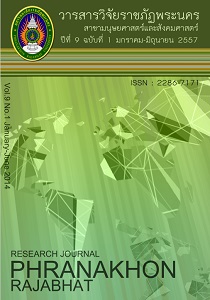การใช้เชื้อเพลิงอัดแท่งที่ผลิตจากวัชพืชและวัสดุที่เหลือใช้จากการทำนา เป็นพลังงานทดแทนในการผลิตเครื่องปั้นดินเผาพื้นบ้าน
Keywords:
เชื้อเพลิงอัดแท่ง, วัชพืช, วัสดุเหลือใช้จากการทำนา, เครื่องปั้นดินเผา, fuel briquettes, weed, rice-farm waste, potteryAbstract
งานวิจัยนี้เป็นการศึกษาการผลิตเชื้อเพลิงอัดแท่งจากวัชพืช และวัสดุเหลือใช้จาก การทำนา (แกลบและฟางข้าว) เพื่อนำมาใช้ทดลองเผาผลิตภัณฑ์เครื่องปั้นดินเผาทดแทน ฟืนไม้ และทำการศึกษาต้นทุนในการผลิตเชื้อเพลิงอัดแท่ง ผลการศึกษา พบว่า เชื้อเพลิง อัดแท่งแบบอัดแห้งและแบบอัดเปียกที่อัตราส่วนผสมระหว่างวัชพืชและวัสดุเหลือใช้จาก การทำนา 50 : 50 โดยน้ำหนัก มีค่าความร้อนสูงที่สุดคือ 3,245 แคลอรี่ต่อกรัม และ 3,012 แคลอรี่ต่อกรัม ตามลำดับ และผลการนำเชื้อเพลิงอัดแท่งทั้ง 2 แบบนี้มาทดลองใช้ เผาผลิตภัณฑ์เครื่องปั้นดินเผาทั้งแบบกลางแจ้งและเผาในเตาเผา เปรียบเทียบกับการใช้ ถ่านกะลามะพร้าวอัดแท่งซึ่งใช้เป็นตัวแทนของเชื้อเพลิงอัดแท่งที่มีจำหน่ายตามท้องตลาด พบว่า ในกรณีเผาแบบกลางแจ้ง การใช้เชื้อเพลิงอัดแท่งแบบอัดเปียกมีอัตราการใช้ เชื้อเพลิงสูงที่สุด คือ 4.13 กิโลกรัมต่อชิ้น มีเปอร์เซ็นต์การเสียหายของผลิตภัณฑ์ 20% รองลงมาเป็นการใช้เชื้อเพลิงอัดแท่งแบบอัดแห้งซึ่งมีอัตราการใช้เชื้อเพลิง 3.53 กิโลกรัม ต่อชิ้น เปอร์เซ็นต์การเสียหายของผลิตภัณฑ์เท่ากับ 6.66% และการใช้ถ่านกะลามะพร้าว อัดแท่งเป็นเชื้อเพลิงพบว่ามีอัตราการใช้เชื้อเพลิงต่ำที่สุดคือ 2.92 กิโลกรัมต่อชิ้น โดยผลิตภัณฑ์ไม่มีการเสียหายเลย ส่วนการเผาในเตาเผา พบว่า อัตราการใช้เชื้อเพลิงและ เปอร์เซ็นต์การเสียหายของการใช้เชื้อเพลิงอัดแท่งทั้ง 3 แบบนี้มีค่าลดลงเมื่อเปรียบเทียบ กับการเผาแบบกลางแจ้ง ผลการศึกษาต้นทุนการผลิตเชื้อเพลิงอัดแท่งแบบอัดแห้งพบว่ามี ต้นทุนการผลิต 2.14 บาทต่อกิโลกรัม ซึ่งต่ำกว่าราคาถ่านกะลามะพร้าวอัดแท่งและไม้ฟืน
THE UTILIZATION OF FUEL BRIQUETTES FROM WEEDS AND RICE-FARM WASTE FOR POTTERY PRODUCTION
This research is to study the utilization of fuel briquettes made from the weed and rice-farm waste (rice husk and straw) for apply to fire pottery wares instead of using firewood, and also production cost assess of briquettes. The result of the study reveals that the dry densification fuel briquettes and wet densification fuel briquettes at the mixed ratio between the weed and rice-farm waste 50 : 50 by the weight, give the highest heating value at 3,245 and 3,012 cal/g respectively. Both types of fuel briquettes were used to fire pottery wares both open-air firing and firing in the pottery kiln compared with using the coconut shell charcoal briquettes, used as agent of fuel briquettes sold in the market. The finding is that; for open-air firing using the wet densification fuel briquettes has the most fuel consumption rate; 4.13 kg/piece and the damaged pottery wares is 20%. For using the dry densification fuel briquettes, the fuel consumption rate is 3.53 kg/piece while the damaged pottery ware is 6.66%. Another finding is that using the coconut shell charcoal briquettes has the least fuel consumption rate, 2.92 kg/piece with no ware damages. For firing in the pottery kiln, the fuel consumption rate and the damaged pottery wares for using the three types of the fuel briquettes was decreased compared to open-air firing. The result of economical investment study found that the production cost of dry densification fuel briquettes was 2.14 kg/baht. This production cost was lower than the cost of coconut shell charcoal briquettes and firewood.
Downloads
Issue
Section
License
โปรดกรอกเอกสารและลงนาม "หนังสือรับรองให้ตีพิมพ์บทความในวารสารวิจัยมหาวิทยาลัยราชภัฏพระนคร สาขาวิทยาศาสตร์และเทคโนโลยี" ก่อนการตีพิมพ์




